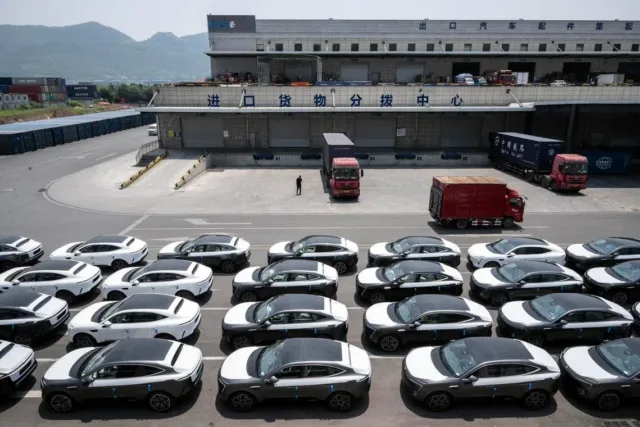KUALA LUMPUR – For most drivers, seeing your car’s range drop to zero kilometres can be panic-inducing, and could portend a hike to the nearest fuel station to bring back a bottle or two of petrol.
Imagine if it happened with an electric vehicle (EV) and there was no charger in sight to juice up the car. Engineer Russell Ng had this happen with his Proton e.MAS 7 – the battery in the vehicle went totally flat while he was on the road.
But he said he barely broke a sweat.
“No big deal,” said Mr Ng, who bought the car in February, just two months after Malaysian Prime Minister Anwar Ibrahim
launched the electric SUV
.
“It was fine. It hit zero per cent just a short distance before I got to my condo in Johor Bahru, which has AC charging.”
The 45-year-old father of two said he knew of other electric car owners who managed to drive another 10km after their battery had ostensibly dropped to zero.
Such calm about what is commonly referred to as range anxiety in EV owners would have been unheard of just a few years ago, when these vehicles were still a niche product for the adventurous few in South-east Asia.
Up until 2021, no Asean market saw electric cars – including plug-in hybrids – make up more than 3 per cent of total industry volume.
Chargers, even in downtown Kuala Lumpur, were a curiosity and many internal combustion engine (ICE) cars would be – selfishly – parked at these charging spots. They were, in any case, vacant most of the time, considering that a mere 274 electric cars were sold in 2021.
Today, however, EVs are easily spotted in most capitals. In 2024, about one in 11 of more than three million cars sold in the region was electric, with EV sales growing by nearly 50 per cent from the previous year.
Singapore has had the most enthusiastic take-up, with nearly half of all new cars registered in 2025 being EVs thus far. In other regional markets, such as Vietnam and Thailand, EV registration has also raced to double-digit percentage market shares.
Amid this growing wave of EV popularity in Asean, national brands such as Malaysia’s Proton and Vietnam’s VinFast are attempting to build on their legacy and market presence, launching their own models against an aggressive push by Chinese makers.
Their expansions have been costly, and it remains to be seen if local automotive players can compete with the influx of foreign vehicles.
For now, ICE cars will continue to make up the bulk of the vehicle population, but their market share is expected to erode steadily, even in Malaysia and Indonesia, which lag behind some of their Asean peers in EV adoption.
In Malaysia, the entrance of Proton should charge up the interest in fully electric cars, which made up 4.3 per cent of registrations in the first half of 2025, doubling to more than 16,000 units. Hybrids did slightly better at 4.7 per cent.
Resistance here comes from the lack of familiarity with EVs, as well as the fact that petrol remains cheap.
“The ecosystem needs further development to ease worries of range anxiety but the price of cheaper ICE options, as well as the subsidised price of petrol in Malaysia, mean many consumers are not willing to make the switch to EV due to economic reasons,” Proton New Energy Technology (PRO-NET) chief executive Zhang Qiang told The Straits Times.
“We foresee this situation changing as more locally produced and cheaper EVs are introduced and the charging infrastructure improves, but it will take some time to match the market penetration of our neighbours.”
Malaysia’s RON95 unleaded fuel was already the cheapest in Asia, bar Brunei, before the government
dropped the price by 6 sen
to RM1.99 (61 Singapore cents) per litre in September. Even the unsubsidised rate of RM2.60 for foreigners is still cheaper than elsewhere in Asean, excluding Brunei.
Malaysian EV owners told ST that if they had to rely on commercial chargers instead of those at home or other subsidised points, such as in workplaces, they would reap little to no fuel cost savings.
Home electricity costs vary according to the household’s usage, but a standard e.MAS 7 battery will cost about RM30 for a full charge, giving drivers a range of around 300km in real-world conditions. An equivalent ICE car would cost around double for the same mileage.
The fastest commercial chargers in Malaysia can cost more than RM100 for the same amount of energy.
In Indonesia, electric cars made up just under 10 per cent of car sales in the first half of 2025.
EV take-up is hampered in part by a lack of charging infrastructure across the 17,500 islands. The state electricity company reported in May that there were just 3,772 public charging stations nationwide for four-wheeled vehicles – though there are nearly 10,000 points available for two-wheelers – fewer than Malaysia’s 4,161, and a stark contrast to Singapore, which has 15,300 EV charging points, and plans to expand them to 60,000 by 2030.
Still, EVs continue to stake their claim among the three million to four million cars sold in South-east Asia every year. The regional EV market, worth US$7.8 billion (S$10.14 billion) in 2024, is expected to double to US$14.9 billion in a decade, led by Thailand, Vietnam and Singapore in take-up rates.
“EVs are inevitable,” said industry expert Paul Tan, whose eponymous website is Malaysia’s most visited motoring portal. “The journey has just begun with this technology, and already it is proving that plugging into a national grid of large power plants is more efficient than using millions of little generators.”
Across the region, Chinese EV makers are well ahead of the competition, given their long track record and cost-competitiveness. Data analytics firm Kpler estimates that for every 10 EVs sold in Indonesia, Malaysia, Vietnam, Thailand, Singapore and the Philippines, seven are from China.
EVs have become a key export to Asean as Chinese firms seek to diversify, with sales sagging in the world’s second-largest economy as a result of a weak economy, as well as market saturation.
Total vehicle sales in China are expected to grow 3 per cent in 2025, down from 4.5 per cent in 2024, according to official estimates. EVs are the lone bright spot, with a projected growth of 20 per cent from a year ago.
But the oversupply of cars has led to savage price competition and prompted Beijing to repeatedly warn its carmakers to compete rationally and not sell cars below their cost price.
It has become even more urgent for Chinese carmakers – including many that have never seen a profit – to “go overseas or go bust” and find new markets.
The dominance of Chinese EVs is particularly stark in Thailand, South-east Asia’s biggest EV market, where massive billboards advertising Chinese makes dominate the skyline on the drive into the city centre from Bangkok’s main international airport.
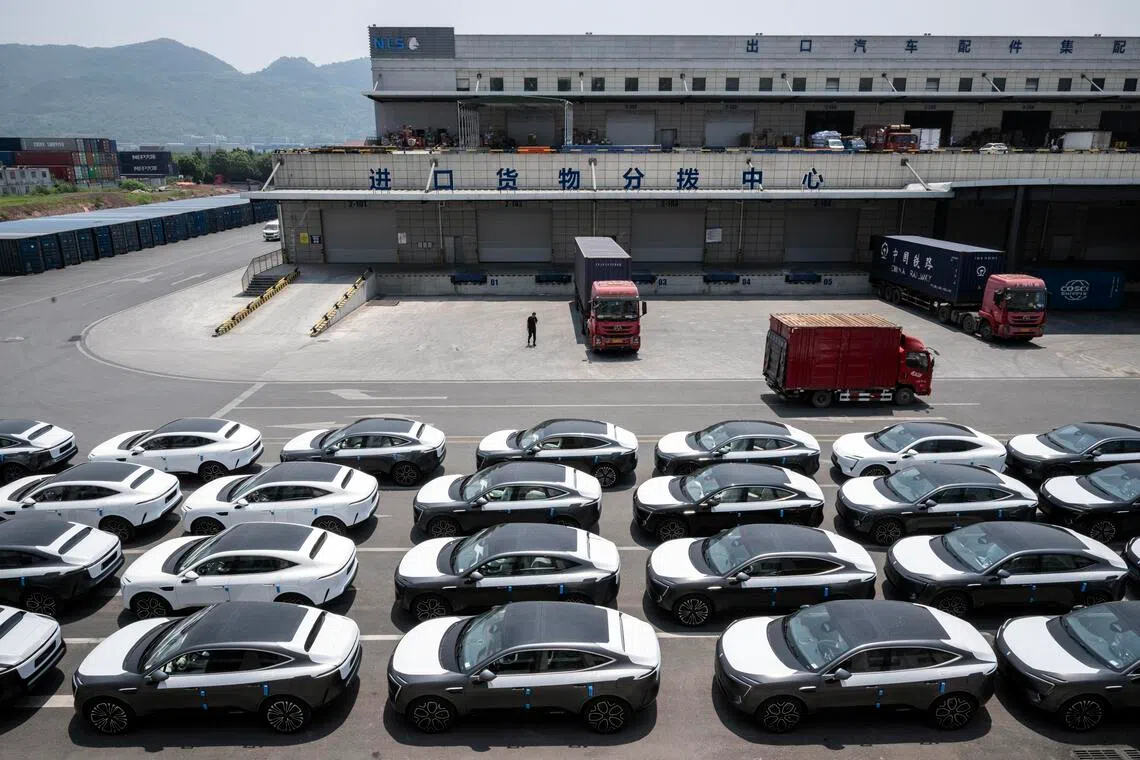
EVs in Chongqing, China, awaiting export to Thailand. The dominance of Chinese EVs is particularly stark in Thailand.
PHOTO: GILLES SABRIE/NYTIMES
New EV registrations in Thailand reached 66,000 units in the first seven months of 2025, almost surpassing the full-year total of 67,000 in 2024, and making up 18 per cent of the total market.
Chinese brands account for more than 80 per cent of all EV sales in Thailand, with BYD the single largest player. The price war between rival makers has proved enticing for Thai consumers in an otherwise stubbornly weak broader automobile market.
The shift has resulted in a major upheaval in the Thai automobile market, traditionally dominated by incumbent Japanese brands like Toyota and Honda, which have been slower to pivot to EV technology.
Suzuki and Subaru have ceased production in Thailand, while Honda will shutter one of its main plants in Ayutthaya by the end of 2025, more than halving its production capacity in the country, from 270,000 vehicles a year to 120,000. Thousands of job losses, including from auto part factories supplying Japanese carmakers, have resulted.
The hyper-competition among Chinese EV makers has also spilled over into Thailand. Neta, among the earliest Chinese brands to enter Thailand in 2022, was for a period the second-best seller after BYD. In June, Neta’s parent company, Hozon, entered bankruptcy proceedings in China, and showrooms and after-sales services have shuttered in Thailand.
The same fate befell Neta’s Singapore operations just three months after it entered the market in January.
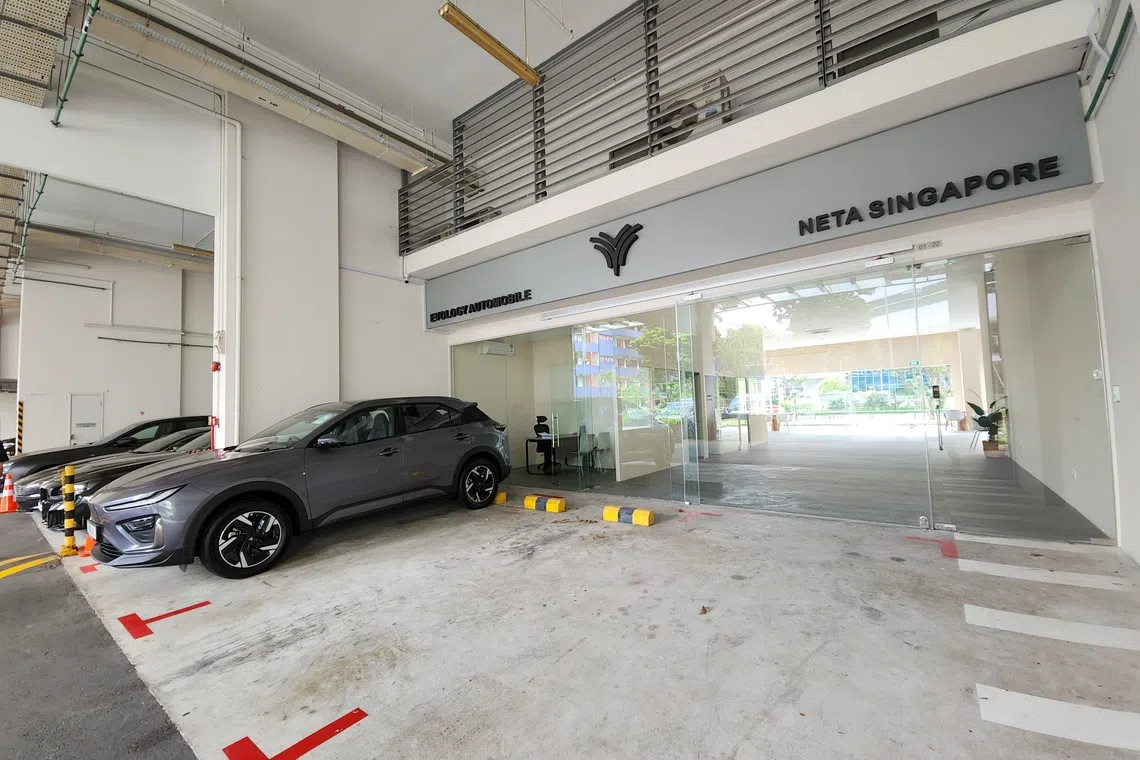
Chinese brand Neta’s showroom opened at One Commonwealth in Singapore in
January but closed its operations three months later.
PHOTO: THE BUSINESS TIMES
In Malaysia, the government has imposed a floor price of RM100,000 for imported electric cars in the face of Chinese brands entering the market, leading to a host of models retailing just a few thousand ringgit above the minimum.
Despite the protectionist move, BYD still dominates the market, making up more than a third of EVs sold once its premium sub-brand Denza is factored in.
Other Chinese EV makers, including Xpeng and Zeekr, as well as Elon Musk’s Tesla, also have significant traction among car buyers.
BYD is also the top EV brand in Indonesia and features at No. 6 among all car makes for the first half of 2025, behind the traditional Japanese giants Toyota, Daihatsu, Honda, Mitsubishi and Suzuki.
In Singapore, BYD, which started business in 2016 with just seven registrations,
was the top-selling car brand among authorised distributorships in 2024
, and is poised to be the overall leader in 2025.
The brand has posted sustained monthly growth increases since January 2025. In the first eight months of 2025, BYD registered 6,467 cars, representing 19.4 per cent of total car registrations, ahead even of Japanese giant Toyota, which has a 14.4 per cent market share.
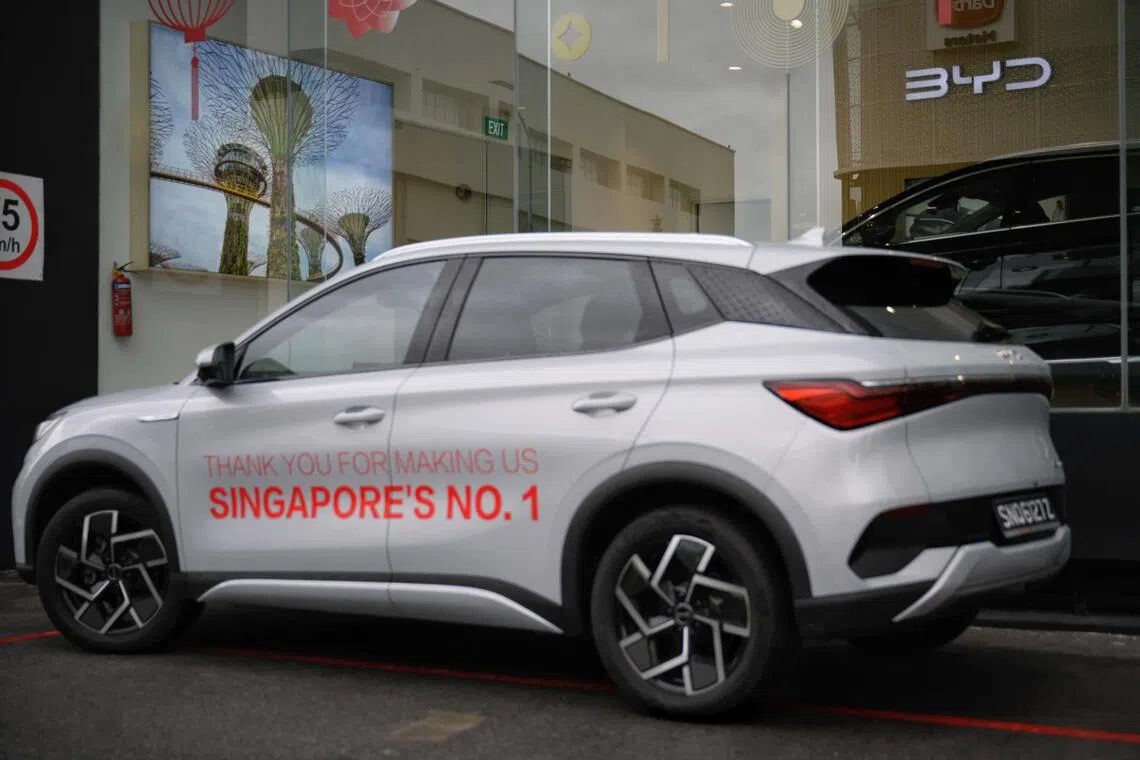
In Singapore, BYD was the top-selling car brand among authorised distributorships in 2024, and is poised to be the overall leader in 2025.
PHOTO: ST FILE
Overall, electric car registrations stood at 42 per cent of total registrations in the first eight months of 2025, up from 33.6 per cent at the end of 2024, and 18.1 per cent in 2023.
As elsewhere in the region, Chinese electric cars
dominate the Singapore market
. In 2024 alone, eight new Chinese brands were introduced in Singapore, bringing the total to 11. So far in 2025, another four have started operations and more have been announced for 2026.
Among Asean’s national carmakers, Malaysia’s Proton and Vietnam’s VinFast are leading the way in playing catch-up.
In fact, Proton’s e.MAS 7 was the best-selling EV model in Malaysia for the first nine months of 2025, with 6,655 units, or one out of every four electric cars, sold in Malaysia.
Risk-averse buyers see the familiar Proton brand as the perfect mix of value for money and reliability, even if the vehicle is, for all intents and purposes, a rebadged Geely – the Chinese automotive conglomerate that owns 49.9 per cent of Malaysia’s first car brand.
“My wife has wanted to change to an EV to be more environmentally sustainable,” bank executive Stanley Hoong Yik Miin, 49, told ST. “We waited for Proton because we were worried about after-sales service, and Proton is here to stay as our national carmaker. There are brands that go bankrupt, and the moment they go, I won’t know who to look to any more (for after-sales support).”
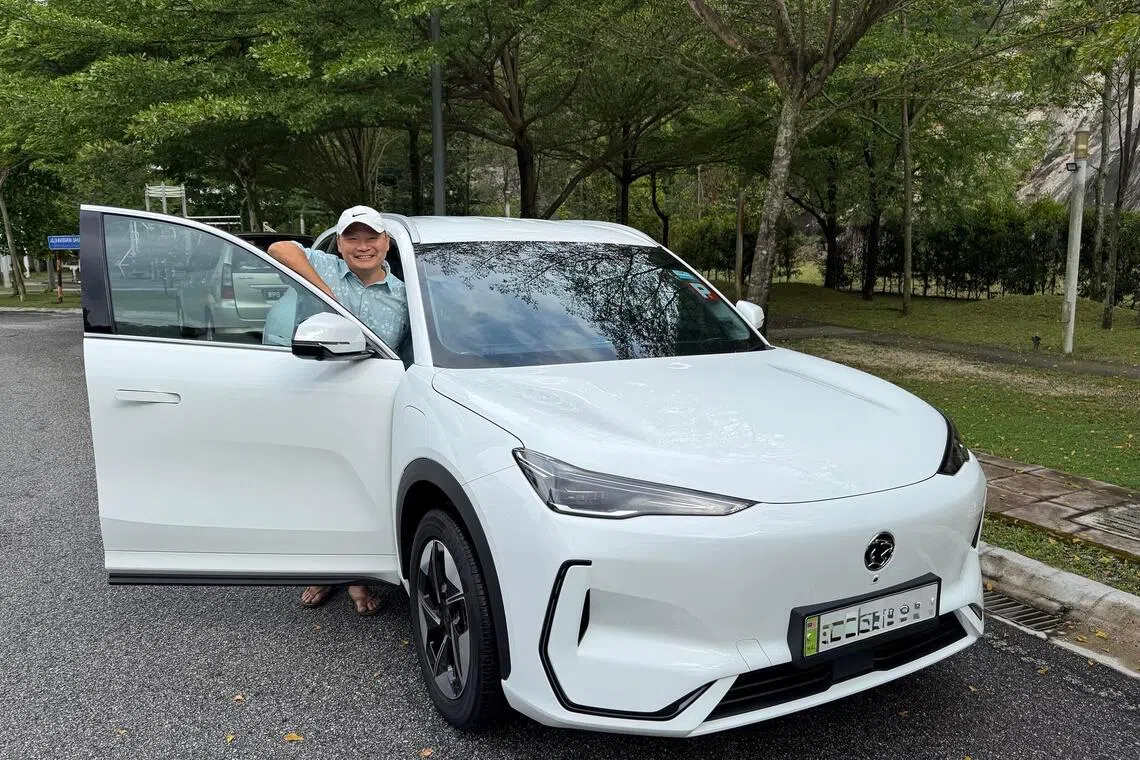
Malaysian bank executive Stanley Hoong bought Proton’s e.MAS 7 as he believes the national carmaker’s EV is here to stay.
ST PHOTO: SHANNON TEOH
With the successful launch, Proton will now manufacture the e.MAS 7 and the upcoming smaller e.MAS 5 at
a new factory in Tanjung Malim, Perak
, which has a capacity of 20,000 EVs a year that can be expanded to 45,000 units.
The price for the e.MAS 7 is then also likely to dip below RM100,000 from its current starting price of RM105,800 while the e.MAS 5 – which garnered 3,000 bookings a week after orders opened on Oct 4 – is set to be priced between RM60,000 and RM80,000.
And after an absence of 12 years from the Singapore market, Proton
announced its return
in August 2025, with the e.Mas 7 going on sale in September.
Still, the likes of BYD are not sitting on their hands. It repriced its 2025 Atto 3 to RM123,800 – an astonishing RM44,000 lower than when it was launched in 2023 – to bring the car within range of the e.MAS 7, whose premium model is at the same price.
It has also earmarked the second half of 2026 to begin local production, as Proton’s neighbour in Tanjung Malim, which would allow it to go below the RM100,000 price floor.
PRO-NET head Mr Zhang believes that “as more (locally assembled) models are introduced and the cost of parts goes down, there is potential for even lower prices when we expand the model range, so there is no reason why the price of EV models cannot match their ICE equivalents in the future”.
Mr Tan of the motoring website estimates that nearly two-thirds of the 700,000-odd cars sold in Malaysia fall within the sub-RM100,000 range, suggesting that EV sales could organically triple once the price barrier is breached.
But to entrench EV adoption – a key plank in reaching net-zero carbon emission targets – it has to make economic sense to the consumer.
“We suggest special subsidies for EV buyers living in apartments or (in a high-rise) without home charging points, so that urban residents are not disadvantaged in making the switch. Beyond rebates for (lower-income) households and fleet incentives for taxis and government vehicles, we propose a personal income tax rebate for consumers who replace their ICE vehicles with EVs priced below RM80,000,” said Mr Zhang.
For now, the government is keeping tabs by limiting the number of EVs being built for domestic sale to avoid flooding the market. On the other hand, it wants carmakers to locate their manufacturing bases in Malaysia.
“You want to build more than that? Can, but export it because we want to make Malaysia an export hub as well,” Investment, Trade and Industry Minister Tengku Zafrul Aziz told ST.
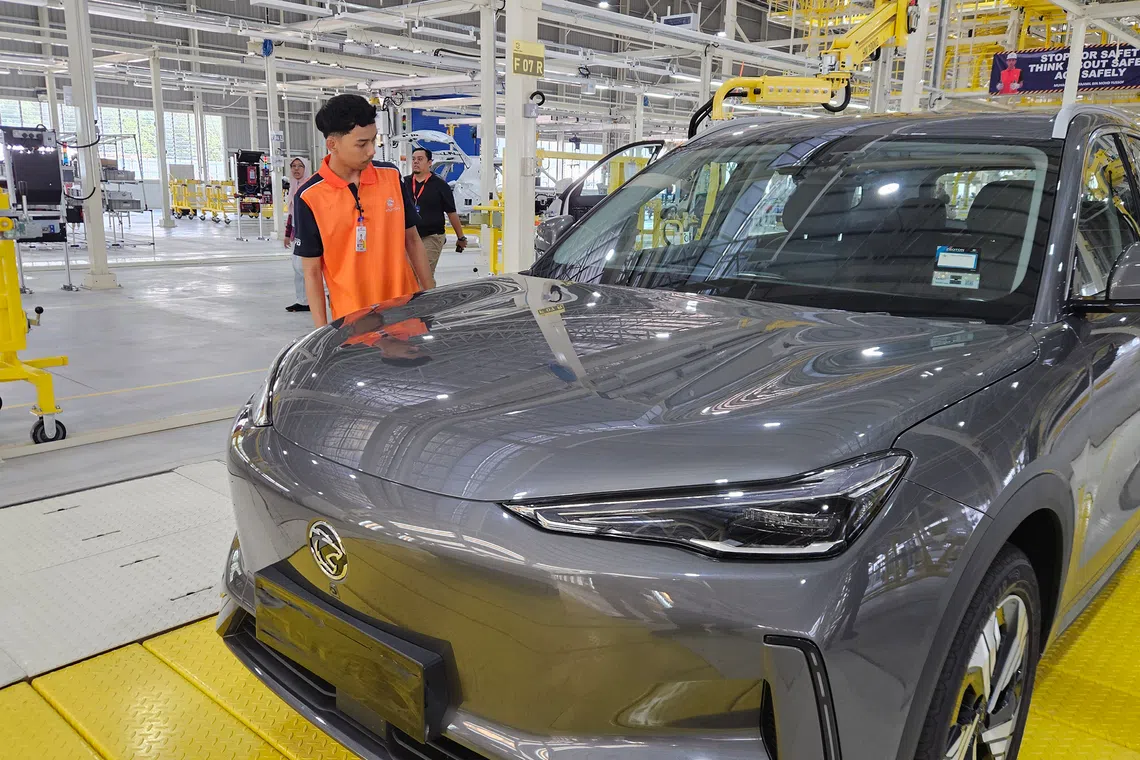
Proton’s factory in Tanjung Malim, Perak, has a capacity of 20,000 EVs a year that can be expanded to 45,000 units.
ST PHOTO: LU WEI HOONG
The production limit will also vary according to the proportion of local parts used. Along with tax breaks for local content, the policy is meant to protect the 700,000 jobs in the automotive industry, which contributes 5 per cent of GDP.
“What we don’t want is when we say ‘stop importing CBU (completely built units)’… they import all the parts, and then they just assemble. The value add, it’s not that great. So this is where we also insist on local content and if you don’t want as much local content, this is the number of cars you can do,” Datuk Seri Zafrul added.
Thailand has also offered generous subsidies and tax breaks for firms to manufacture locally with the aim of converting 30 per cent of auto production to EVs by 2030, and to establish the country as a major EV export hub.
The policies have drawn more than US$4 billion in investment in new factories in Thai industrial hubs such as Rayong and Chonburi, from big-name market leaders like BYD, Great Wall Motors and Changan, and even smaller, lesser-known players.
Among the conditions in return for the generous tax incentives imposed by the Thai government was for EV firms to eventually manufacture more cars locally than they import. EV companies were expected to manufacture one EV for every vehicle they imported in 2024, rising to 1.5 made for each import in 2025, as well as quotas for locally sourced car parts.
But carmakers have mostly missed those targets, and in July, Thailand’s Board of Investment said it would relax its production requirements to include exported vehicles.
In Indonesia, Djarum Group launched two domestically assembled EVs in May 2025, becoming the first Indonesian company to do so. The vehicles are reportedly produced at a plant in Central Java, mainly from parts imported from China.
Vietnam has thrown its weight behind national champion VinFast, a subsidiary of the country’s largest conglomerate Vingroup, and bankrolled by the country’s richest man, billionaire Pham Nhat Vuong.
With government support for land acquisition, generous subsidies and import duty exemptions on local assembly, and lower registration fees on its electric cars, VinFast has been able to translate its head start into dominance, accounting for more than 87,000 of the 91,500 EV units sold in Vietnam in 2024.
In fact, VinFast leads in all categories, electric or otherwise, making up 30 per cent of new automobile sales, though sales figures have been boosted by fleet sales to related parties like Xanh SM,
the all-electric ride hailing service
whose cheerful teal taxis are ubiquitous across the country.
VinFast is seeking aggressive expansion in a youthful and growing Vietnamese market, while also digging a moat against recent Chinese entrants like BYD. It has used its home advantage to build a network of proprietary charging stations, many embedded within the vast network of shopping centres and real estate mega-complexes developed by Vingroup.
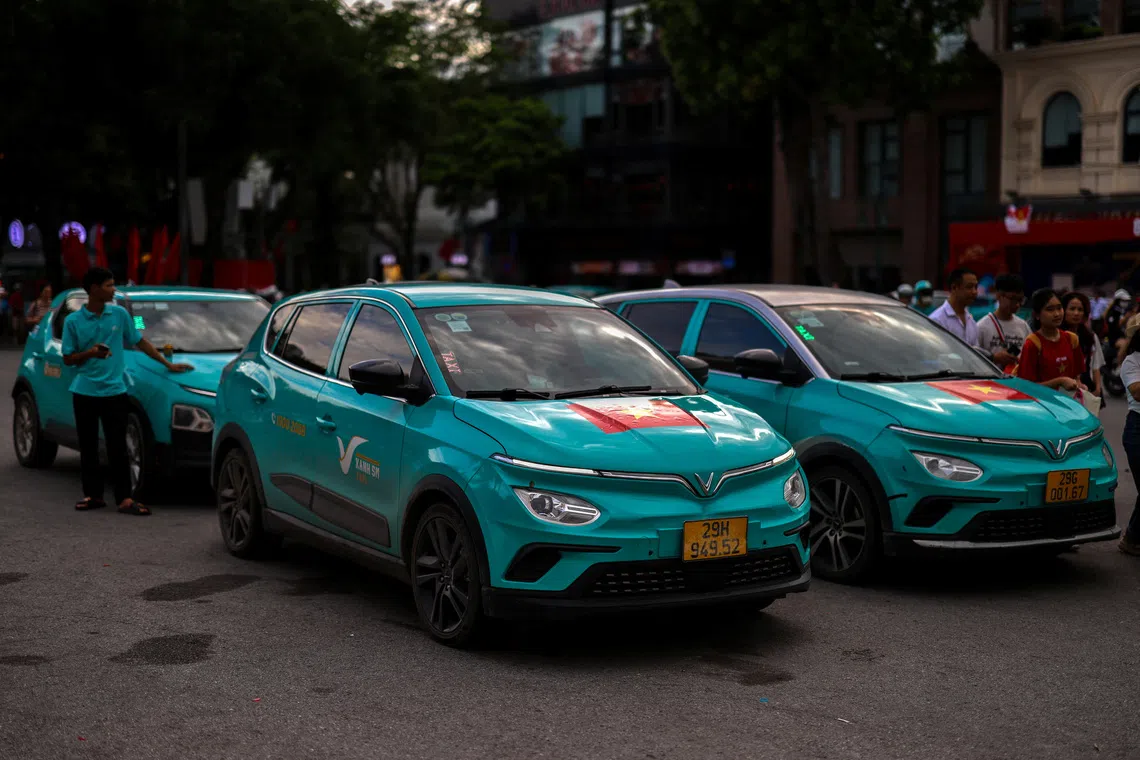
Xanh SM’s cheerful teal taxis are ubiquitous across Vietnam.
PHOTO: REUTERS
But beating the Chinese at their own game has proven expensive, and VinFast, in particular, has been burning cash at a precipitous rate.
The company booked more than US$3 billion in losses in 2024, and another US$1.5 billion in the first half of 2025 alone, despite more than tripling its sales. Mr Pham has personally committed more than US$2 billion so far in 2025, on top of a US$1.2 billion loan to VinFast from parent Vingroup in May.
VinFast, however, has maintained a bullish attitude, pointing out that its strong sales growth has also meant that its expenses and cash burn were lower as a percentage of revenue.
“Our path to profitability is driven by scaling volumes while being disciplined on costs – that hasn’t changed,” VinFast chief financial officer Nguyen Thi Lan Anh said at the company’s most recent quarterly earnings result in September.
“Our business is now at an inflection point where we expect economies of scale to drive greater operating leverage going forward.”
Indeed, by the end of the year, Vietnam could overtake Thailand as South-east Asia’s biggest EV market. Between January and August, EVs accounted for 26 per cent of all cars sold in Vietnam, with nearly 90,000 units in just eight months.
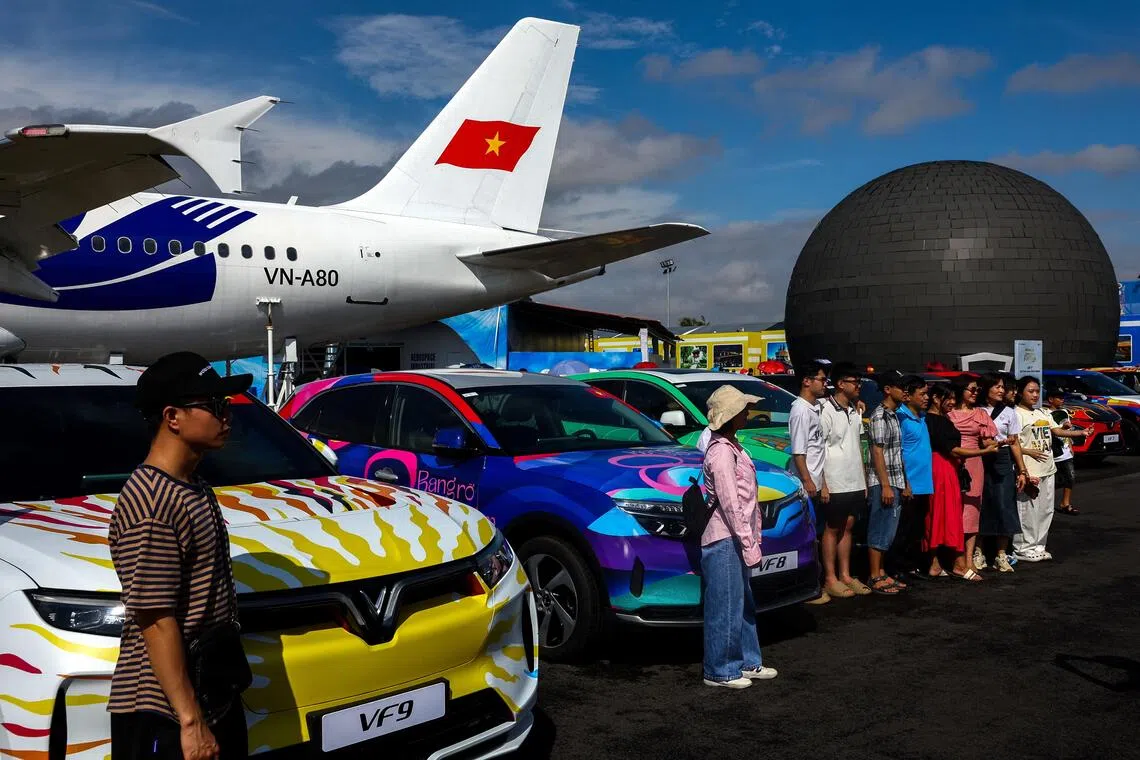
VinFast electic cars on display at the National Exhibition Centre in Hanoi on Aug 31. VinFast accounted for more than 87,000 of the 91,500 EV units sold
in Vietnam in 2024.
PHOTO: REUTERS
VinFast is far from the only EV start-up to go deep in the red. But if the strategy is to scale at all costs and expand into overseas markets to have a chance at profitability, success will mean challenging the likes of BYD and Tesla head on without home ground advantage.
In June, VinFast unveiled plans to increase production capacity fourfold to one million cars per year by 2030. On top of its flagship Hai Phong plant, it inaugurated a second Vietnam factory in Ha Tinh province in June, and then
its first overseas plant in India’s Tamil Nadu
just weeks later. It is also due to open a manufacturing facility in Subang, Indonesia, later in 2025, though it has shelved plans for a US factory due to poor initial sales.
Malaysia’s Proton is similarly important to the national economy, and its revival since Geely’s involvement has seen a turnaround in its fortunes after decades of being dogged by reliability issues and a lack of competitive products. This saw its market share fall from 80 per cent and ground ceded to Perodua, the nation’s second carmaker, which has topped annual sales charts since 2006.
For a few years in the mid-2010s, Proton even fell to third behind Honda, before the Geely era brought new models that boosted its market share from a low of 11 per cent in 2018 to over a fifth in 2020.
Civil servant Abang Abdul Rasyid Abang Yusop told ST that before buying his e.MAS 7 he was “worried about Proton’s old reputation for faulty power windows and weak engines, but Geely’s involvement changed that”.
“Driving my family’s ICE car once in a while now and then reminds me why I prefer my EV,” he said.

Civil servant Abang Abdul Rasyid Abang Yusop (left) now prefers the Proton e.MAS 7 EV to his regular family car.
PHOTO: COURTESY OF ABANG ABDUL RASYID ABANG YUSOP
Mr Zhang said Proton now leads the local market in the number of after-sales service centres and “we have also done a lot to improve our product quality, which is now a match for Geely and has improved by more than 10 times compared to where it was in 2017”.
Now, the paradigm shift towards EVs is set to be a game changer, with Japanese brands falling off the pace. But it remains to be seen if Proton, and indeed Perodua, which is lining up an electric car debut by end-2025 at no more than RM80,000, can go toe-to-toe with their Chinese counterparts.
Proton’s strategy is to ensure scalability by targeting sales of half a million units by 2035, with half coming from exports. Aside from Singapore, the e.MAS 7 has been launched in Trinidad and Tobago, Nepal and Mauritius.
For Mr Hoong the bank executive, who owned two ICE Proton models when he was younger, the fact that all recent models from the brand are essentially Geelys means he has peace of mind that the e.MAS 7’s “platform has been around for a long time”.
“In fact, it does feel like it’s a case of two Chinese brands competing – Geely and BYD. We wanted an EV regardless, but Geely and Proton have just been around longer.”
Prior to the e.MAS 7, Protons and Peroduas assembled in Malaysia generally had between 70 per cent and 90 per cent of local content.
But how much of an EV can be locally produced remains to be seen. If Proton and Perodua fail to reach such highs – and it is unlikely that others like BYD will as well – then the local supply chain will be in danger of shrinking.
Given question marks over VinFast’s sustainability, there is a likelihood that the main beneficiary of South-East Asia’s EV push would eventually be China.
-
Additional reporting by Lee Nian Tjoe


